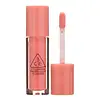What's inside
What's inside
 Key Ingredients
Key Ingredients

No key ingredients
 Benefits
Benefits

No benefits
 Concerns
Concerns

 Ingredients Side-by-side
Ingredients Side-by-side

Water
Skin ConditioningMethyl Trimethicone
Skin ConditioningDimethicone
EmollientCetyl Ethylhexanoate
EmollientIsononyl Isononanoate
EmollientAlcohol Denat.
AntimicrobialPolybutene
Polypropylsilsesquioxane
Butylene Glycol
HumectantGlycerin
HumectantPEG-10 Dimethicone
Skin ConditioningPentylene Glycol
Skin ConditioningVinyl Dimethicone/Methicone Silsesquioxane Crosspolymer
1,2-Hexanediol
Skin ConditioningChlorella Vulgaris Extract
Skin ConditioningPrunus Armeniaca Fruit Extract
Skin ConditioningSodium Hyaluronate
HumectantDisteardimonium Hectorite
StabilisingMagnesium Sulfate
Bis-Diglyceryl Polyacyladipate-2
EmollientCetyl PEG/PPG-10/1 Dimethicone
EmulsifyingGlucose
HumectantFructooligosaccharides
HumectantFructose
HumectantEthylhexylglycerin
Skin ConditioningTrisodium Ethylenediamine Disuccinate
Triethoxycaprylylsilane
Panthenol
Skin ConditioningAluminum Hydroxide
EmollientPentaerythrityl Tetra-Di-T-Butyl Hydroxyhydrocinnamate
AntioxidantTocopherol
AntioxidantCI 77891
Cosmetic ColorantCI 77492
Cosmetic ColorantMica
Cosmetic ColorantCI 77491
Cosmetic ColorantCI 73360
Cosmetic ColorantCI 77007
Cosmetic ColorantIron Oxides
Water, Methyl Trimethicone, Dimethicone, Cetyl Ethylhexanoate, Isononyl Isononanoate, Alcohol Denat., Polybutene, Polypropylsilsesquioxane, Butylene Glycol, Glycerin, PEG-10 Dimethicone, Pentylene Glycol, Vinyl Dimethicone/Methicone Silsesquioxane Crosspolymer, 1,2-Hexanediol, Chlorella Vulgaris Extract, Prunus Armeniaca Fruit Extract, Sodium Hyaluronate, Disteardimonium Hectorite, Magnesium Sulfate, Bis-Diglyceryl Polyacyladipate-2, Cetyl PEG/PPG-10/1 Dimethicone, Glucose, Fructooligosaccharides, Fructose, Ethylhexylglycerin, Trisodium Ethylenediamine Disuccinate, Triethoxycaprylylsilane, Panthenol, Aluminum Hydroxide, Pentaerythrityl Tetra-Di-T-Butyl Hydroxyhydrocinnamate, Tocopherol, CI 77891, CI 77492, Mica, CI 77491, CI 73360, CI 77007, Iron Oxides
Hydrogenated Polyisobutene
EmollientHydrogenated Poly(C6-14 Olefin)
EmollientMica
Cosmetic ColorantOctyldodecanol
EmollientHydrogenated Styrene/Isoprene Copolymer
Isododecane
EmollientTrimethylsiloxysilicate
EmollientCI 77891
Cosmetic ColorantCI 15985
Cosmetic ColorantSorbitan Sesquioleate
EmulsifyingPentylene Glycol
Skin ConditioningDisteardimonium Hectorite
StabilisingCaprylyl Glycol
EmollientPropylene Carbonate
SolventCI 77491
Cosmetic ColorantCI 45410
Cosmetic ColorantParfum
MaskingCI 15850
Cosmetic ColorantTriethoxycaprylylsilane
Aluminum Hydroxide
EmollientCitronellol
PerfumingLinalool
PerfumingCoumarin
PerfumingHydrogenated Polyisobutene, Hydrogenated Poly(C6-14 Olefin), Mica, Octyldodecanol, Hydrogenated Styrene/Isoprene Copolymer, Isododecane, Trimethylsiloxysilicate, CI 77891, CI 15985, Sorbitan Sesquioleate, Pentylene Glycol, Disteardimonium Hectorite, Caprylyl Glycol, Propylene Carbonate, CI 77491, CI 45410, Parfum, CI 15850, Triethoxycaprylylsilane, Aluminum Hydroxide, Citronellol, Linalool, Coumarin
 Reviews
Reviews

Ingredients Explained
These ingredients are found in both products.
Ingredients higher up in an ingredient list are typically present in a larger amount.
Aluminum Hydroxide is a form of aluminum. It can be naturally found in nature as the mineral gibbsite. In cosmetics, Aluminum Hydroxide is used as a colorant, pH adjuster, and absorbent.
As a colorant, Aluminum Hydroxide may add opacity, or reduce the transparency. Aluminum hydroxide is contains both basic and acidic properties.
According to manufacturers, this ingredient is an emollient and humectant. This means it helps hydrate the skin.
In medicine, this ingredient is used to help relieve heartburn and help heal ulcers.
There is currently no credible scientific evidence linking aluminum hydroxide in cosmetics to increased cancer risk.
Major health organizations allow the use of aluminum hydroxide in personal care products and have not flagged it as a carcinogenic risk at typical usage levels.
Learn more about Aluminum HydroxideCi 77491 is also hydrated iron III oxide. It's sole purpose is to give a red/pink hue to products.
Iron III oxides are classified as inorganic chemicals for coloring.
Synthetically created Ci 77491 is considered safer than those naturally found. This is because the synthetically created version may contain less impurities. Iron oxides are generally non-toxic and non-allergenic.
Learn more about CI 77491Ci 77891 is a white pigment from Titanium dioxide. It is naturally found in minerals such as rutile and ilmenite.
It's main function is to add a white color to cosmetics. It can also be mixed with other colors to create different shades.
Ci 77891 is commonly found in sunscreens due to its ability to block UV rays.
Learn more about CI 77891Disteardimonium Hectorite comes from the clay mineral named hectorite. It is used to add thickness to a product.
It can also help stabilize a product by helping to disperse other ingredients.
Hectorite is a rare, white clay mineral.
Learn more about Disteardimonium HectoriteMica is a naturally occurring mineral used to add shimmer and color in cosmetics. It can also help improve the texture of a product or give it an opaque, white/silver color.
Serecite is the name for very fine but ragged grains of mica.
This ingredient is often coated with metal oxides like titanium dioxide. Trace amounts of heavy metals may be found in mica, but these metals are not harmful in our personal products.
Mica has been used since prehistoric times throughout the world. Ancient Egyptian, Indian, Greek, Roman, Aztec, and Chinese civilizations have used mica.
Learn more about MicaPentylene glycol is typically used within a product to thicken it. It also adds a smooth, soft, and moisturizing feel to the product. It is naturally found in plants such as sugar beets.
The hydrophilic trait of Pentylene Glycol makes it a humectant. As a humectant, Pentylene Glycol helps draw moisture from the air to your skin. This can help keep your skin hydrated.
This property also makes Pentylene Glycol a great texture enhancer. It can also help thicken or stabilize a product.
Pentylene Glycol also acts as a mild preservative and helps to keep a product microbe-free.
Some people may experience mild eye and skin irritation from Pentylene Glycol. We always recommend speaking with a professional about using this ingredient in your routine.
Pentylene Glycol has a low molecular weight and is part of the 1,2-glycol family.
Learn more about Pentylene GlycolTriethoxycaprylylsilane is a silicone used to bind and stabilize ingredients.
As an emulsifier, it helps prevent ingredients from separating. This can help elongate the shelf life of products.
Triethoxycaprylylsilane is often used to coat mineral sunscreens ingredients to help give a better feel. It also helps reduce oxidative stress in sunscreens.
Learn more about Triethoxycaprylylsilane